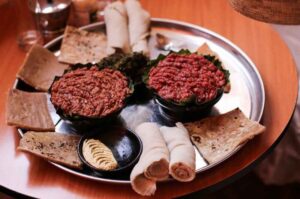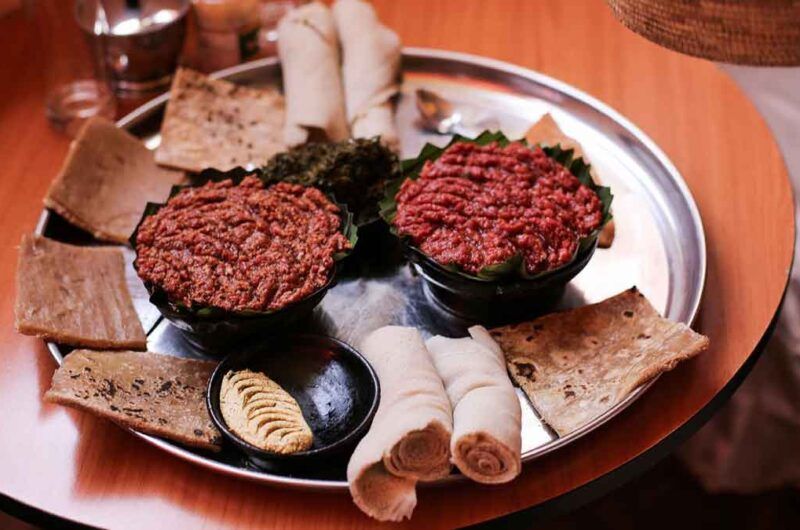Ethiopian food is distinctive and delicious, befitting a remarkable country with a cultural heritage that stands out from the rest of Africa. While the cuisine of Ethiopia is gradually becoming better known, it’s no overstatement to say it remains one of the world’s best-kept secrets.
Eating Ethiopian-style means rethinking many assumptions you might have about dinnertime — for most of us this means starting with eschewing cutlery and being ready to get messy fingers.
That’s because the foundation of the vast majority of Ethiopian meals is injera, a giant gray spongey pancake-like bread, upon whose strangely rubbery surface are served a vast array of foods, ranging from multicolored mounds of spicy stews to vegetable curries to cubes of raw meat.
1. Tibs

Sliced beef or lamb, pan-fried in butter, garlic and onion, tibs is one of the most popular dishes among Ethiopians.
It comes in a variety of forms, varying in type, size or shape of the cuts of meat used, and can range from hot to mild or contain little to no vegetables. A particularly recommended variation is shekla tibs, in which the strips of meat arrive at your table roasting atop a clay pot stoked with hot coals — dramatic and delicious.
Historically, tibs was served to pay a compliment or show respect to someone. Today it’s still viewed as a special dish, hence its popularity for commemorating special events and holidays. At the same time, though, if you walk into a rowdy bar on a Friday afternoon in Ethiopia’s rambunctious capital, Addis Ababa, it’s likely that most of the revelers will be enthusiastically ordering and eating tibs.
2. Fatira

A breakfast dish popular around the Horn of Africa, fatira usually comprises a thin pastry top and bottom with scrambled eggs and honey wedged in the middle. Typically served as a large portion, this perfect combination of savory and sweet can happily feed two.
Fatira also comes in a street food version comprising small square pieces cooked in the open on a giant frying pan in the likes of Ethiopia’s beguiling eastern city of Harar.
Accompanied by freshly brewed Ethiopian coffee, there aren’t many better ways to start a day of exploring Ethiopia.
3. Kitcha fit-fit

Kitcha fit-fit is a fit-fit variety prepared with a combination of torn pieces of kitcha flatbread, clarified butter, and berbere spices. The dish is traditionally served for breakfast, when it’s accompanied by plain yogurt. Unlike most Ethiopian dishes, kitcha fit-fit is typically consumed with a spoon instead of using the right hand.
4. Kitfo

Kitfo is a popular Ethiopian dish consisting of raw beef that is freshly ground and combined with Ethiopian butter (niter kibbeh) and spices such as chili and salt. The dish is served with a variety of breads, with injera being a staple of every restaurant that serves kitfo.
Although kitfo is usually served on its own, it can also be accompanied by salty cheeses or collard greens.



